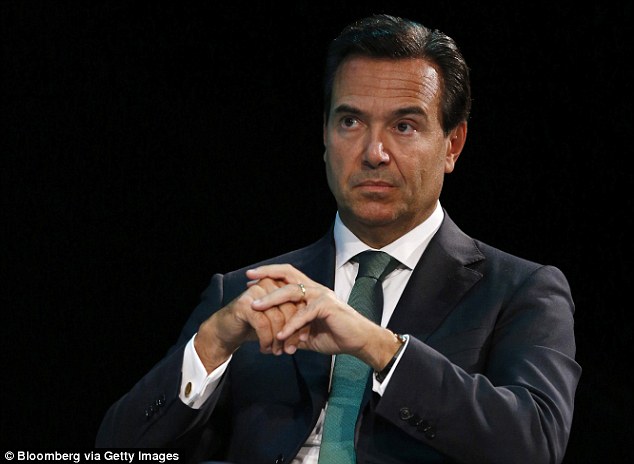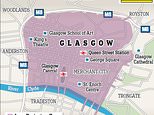MIDAS SHARE TIPS: Looking for a high yield? Hitch up to the black horse bank
So now we know. The Government is planning to sell at least £2billion worth of shares in Lloyds Banking Group to individual investors next March. This begs one obvious question: is the stock a good buy?
To make the question easier to answer, the Government is offering two incentives. First, the shares will be sold at a 5 per cent discount to the prevailing market price and second, anyone who keeps the stock for more than a year will receive one free share for every ten held.
The bonus is capped at £200, but that still means anyone buying shares worth up to £2,000 will, in effect, receive a 15 per cent bonus.
Scroll down for video

Strategy: Chief executive Antonio Horta-Osorio has simplified business at the bank
This sounds compelling – and it is meant to – but it does not mean that everyone should rush to buy without thinking clearly about their investment requirements and whether Lloyds is likely to satisfy them.
Lloyds – 250 years old this year –has changed substantially since it was bailed out by the Government in October 2008, just weeks after rescuing HBOS. Back then, the bank was on its knees. The Government took a 43.4 per cent stake, losses ballooned and dividends stopped.
Since then, the bank has focused on simplifying its business and regaining customers’ trust, by doing what high street clearers used to do – lend money to individuals via mortgages and consumer finance; lend money to businesses via easy-to-understand loans; and provide customers with current and savings accounts, as well as some financial and retirement planning via its Scottish Widows subsidiary.
Along the way, chief executive Antonio Horta-Osorio has worked hard to cut costs, improve profits and return to paying dividends. In February this year, while announcing annual profits of £1.75billion, he reached a milestone when he unveiled a dividend of 0.75p for 2014, the first in six years.
Another 0.75p dividend was announced alongside interim figures in July and analysts expect a total payment of 2.5p for 2015, rising to 4p in 2016 and 5p in 2017.
So far so good. Horta-Osorio seems to know what he is doing, profits of £1.2billion were announced at the interim stage and annual figures of £3.6 billion are forecast for 2015, rising to £7.3billion next year.
However, there are considerable uncertainties surrounding this bank, not least its exposure to the Payment Protection Insurance scandal, which has already cost Lloyds more than £11billion.
The Financial Conduct Authority is thinking about imposing a deadline of spring 2018 for all PPI claims, which would draw a line under this disaster once and for all, but that still leaves two-and-a-half years for claimants to come to Lloyds asking for compensation.
As a UK-based bank, Lloyds is also highly exposed to any economic headwinds, particularly around mortgages when interest rates finally start to rise. And banking is a competitive industry, with new players such as Metro Bank, Virgin Money and Aldermore snapping at the heels of established players.

Back to its roots: Lloyds Banking Group nostalgic advert for its 250th year
Concerns about Lloyds’ prospects have hit the shares in recent months. Chancellor George Osborne started selling the Government’s shares in 2013, so 88 per cent of the stock is now in public hands, including 2.8million private investors.
They have seen the stock fall from 88p in May to 72p in September, before recovering to 76p today. Any recurrence of that kind of performance could wipe out the bonus that the Chancellor is promising next year.
Midas verdict: The Lloyds’ share sale is not like other Government flotations. The stock is already traded on the market, Osborne has announced how the shares will be priced and there is the bonus to discourage investors from making a fast buck.
The main attraction of this stock is, in fact, the dividend. A 4p payout in 2016 implies a healthy yield of more than 5 per cent, with generous payments predicted thereafter.
Of course, the shares are not risk-free, but the Lloyds of today and tomorrow is reminiscent of what banking stocks used to be – secure, long-term, high-yielding investments. In other words, an attractive buy for income investors.





Most watched Money videos
- BMW meets Swarovski and releases BMW i7 Crystal Headlights Iconic Glow
- Top Gear takes Jamiroquai's lead singer's Lamborghini for a spin
- Mini celebrates the release of brand new all-electric car Mini Aceman
- 2025 Aston Martin DBX707: More luxury but comes with a higher price
- Land Rover unveil newest all-electric Range Rover SUV
- Mail Online takes a tour of Gatwick's modern EV charging station
- Mercedes has finally unveiled its new electric G-Class
- A look inside the new Ineos Quartermaster off-road pickup truck
- Introducing Britain's new sports car: The electric buggy Callum Skye
- Blue Whale fund manager on the best of the Magnificent 7
- Leapmotor T03 is set to become Britain's cheapest EV from 2025
- Mini Cooper SE: The British icon gets an all-electric makeover
-
 MARKET REPORT: Fresnillo sparkles as gold hits a record high
MARKET REPORT: Fresnillo sparkles as gold hits a record high
-
 Would you work from a car office? Ford patent shows how...
Would you work from a car office? Ford patent shows how...
-
 SSP Group shares slump as profits hit by European rail...
SSP Group shares slump as profits hit by European rail...
-
 I'm 85 and no longer fit to drive. But when I took my...
I'm 85 and no longer fit to drive. But when I took my...
-
 Five magic words you must say to BT if you DON'T want to...
Five magic words you must say to BT if you DON'T want to...
-
 Bitcoin and other cryptos rally as investors eye US...
Bitcoin and other cryptos rally as investors eye US...
-
 BUSINESS LIVE: AstraZeneca eyes $80bn in sales; Credit...
BUSINESS LIVE: AstraZeneca eyes $80bn in sales; Credit...
-
 South West operator Pennon to hand-out £3.5m in...
South West operator Pennon to hand-out £3.5m in...
-
 The one thing you have to add to your shed to make sure...
The one thing you have to add to your shed to make sure...
-
 CVS sells Dutch and Irish vet businesses for just €2
CVS sells Dutch and Irish vet businesses for just €2
-
 Top investor throws weight behind Anglo American break-up...
Top investor throws weight behind Anglo American break-up...
-
 Visa and Mastercard could face transparency crackdown as...
Visa and Mastercard could face transparency crackdown as...
-
 AstraZeneca targets $80bn in yearly revenues by 2030
AstraZeneca targets $80bn in yearly revenues by 2030
-
 Cazoo collapses into administration putting more than 200...
Cazoo collapses into administration putting more than 200...
-
 Screwfix owner Kingfisher suffers 'big-ticket' spending...
Screwfix owner Kingfisher suffers 'big-ticket' spending...
-
 Sajid Javid eyes job at Shein as the Chinese fast fashion...
Sajid Javid eyes job at Shein as the Chinese fast fashion...
-
 Stamp duty on shares must be axed, says London Stock...
Stamp duty on shares must be axed, says London Stock...
-
 Bank sets the scene for summer rate cuts as deputy...
Bank sets the scene for summer rate cuts as deputy...





































































